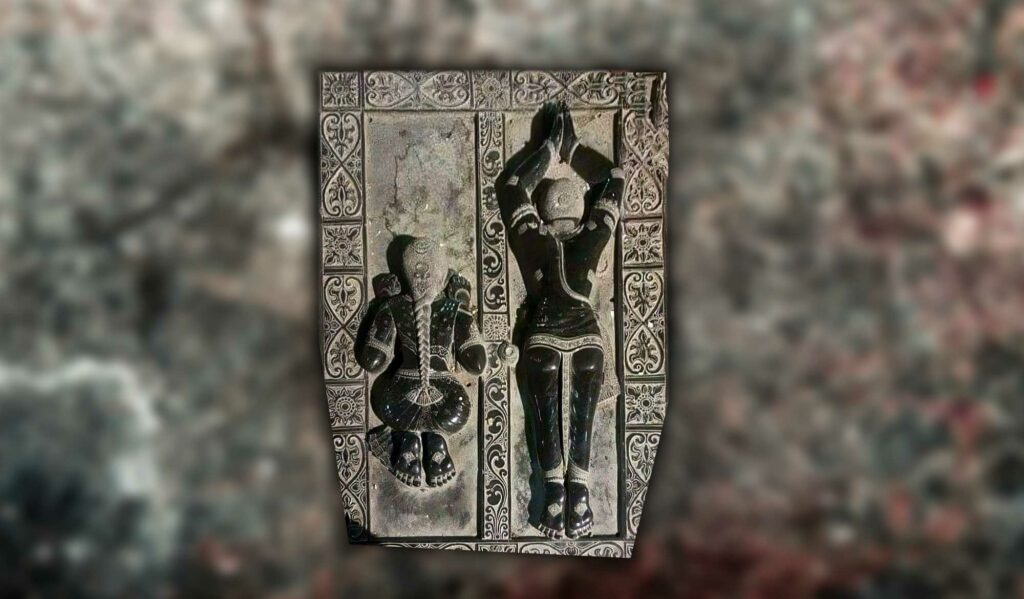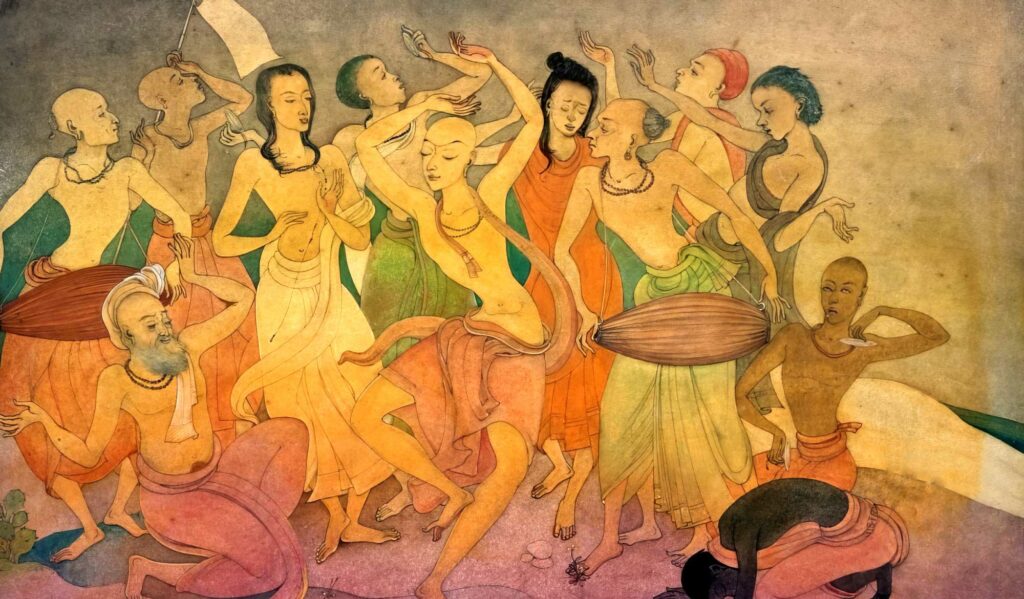Overview
With the forthcoming observance of Śrī Rāma Navamī, we present 'Prabhupāda Śrīla Sarasvatī Ṭhākura’s Visit to Ayodhyā' written by Śrīla Bhaktisiddhānta Sarasvatī Ṭhākura Prabhupāda from The Gaudīyā magazine, Vol 3. Issue 21/ In December 1924, after visiting Benares and Prāyāga, Sarasvatī Ṭhākura visited the birth-site of Śrī Rāmācandra in Ayodhyā.
After a few days, we all reached Ayodhyā station at around 12:00 pm from Benares Cantonment in the company of Śrīpāda Paramānanda and Śrīpāda Kīrtanānanda Brahmācarī. That night we stayed in a dharmaśālā located just behind the station, and the next morning we went to a pāṇḍā’s house about 3-4 miles away.
We went sight-seeing with our guide to touch the waters of the nearby Sarayū River – first we took darśana of Matagajendra Śiva (the servant of Rāma and the kṣetrapāla, or protector of the dhāma) and then we went to Kanaka Bhavan and Ratna-siṅghāsana, the temple where Bharata worshiped the pādukās of Śrī Rāmacandra etc. It would not be an exaggeration to say that Kanka Bhavan is a huge three-storey royal palace made of stone. I heard from the mouth of the pāṇḍā that Śrī Rāmacandra first came to this place after marrying Sītā Devī. On inquiry, I learned that this large temple was built by a rāma-bhakta of Tikamgarh from the Jhansi district of Central India at a cost of lakhs of rupees. In it there are Deities of Śrī Rāma and Sītā. The Ratna-Siṁhāsana temple was built by the efforts and care of a sannyāsī belonging to the Rāmānandī sampradāya — here also there are Deities of Śrī Rāma and Sītā Devī, and on the opposite side a Deity of Śrī Mahāvīra Hanumānjī is worshipped. Then we went to Bharatajī’s temple and saw Śrī Rāma’s pādukās on a throne with Bharatajī sitting below. After passing many temples, we finally took darśana of the Yogapīṭha, the birth-place of Śrī Rāmacandra. Deities of Śrī Rāma and Sītā are served inside a thatched shed on a stone-built altar – next to it is a huge mosque of the Muslims which stands as a burning testimony to Aurangzeb’s hatred for Hindu dharma.
At one time, the whole place was forcibly occupied by the Muslim rulers. Later, as a result of various wars and disputes, the Hindus took over the rights of the Muslims. Just as a mother carefully protects her small son from the hands of a wicked kidnapper by grasping him in both hands and pressing him to her bosom, in the same way, even today, overcoming many obstacles and many tribulations in the midst of extreme torture, they are carefully protecting the land of their worshipable Lord.
Thinking about all these things, our mind began to be simultaneously overwhelmed with great sorrow and joy – why was there sorrow? We are ‘bāndā’ or ‘golam’ (servants) of the same Khoda (God) – we Hindus and Muslims are bound by brotherhood as servants of the same principal Master. By putting this insignificant external identity aside, by being concerned with the external cover, blinded by communal bigotry, we hurt each other’s religious beliefs and create a great wound in society, and gradually that wound spreads like an evil tumor, forcing both parties to journey towards death, making them offenders before the Supreme Lord. However, it is also a matter of happiness that at present, due to the efforts of the British government, religious disputes between both parties are not increasing to such an extent.
At one time, this place was constantly resounding with the sounds of conches, bells, kāṅsaras, mṛdaṅgas and karatālas of the community of enthusiastic worshippers and sevaites. Just as He did with Rāvaṇa, Bhagavān Śrī Rāmacandra destroys the demonic nature which the jīva acquires when trying to enjoy those things that are meant for the enjoyment of Bhagavān. The māyāvādīs beg for mundane prestige. They do not consider the ingredients of service to Bhagavān as worshipable. Due to bewildering lust, they hurry to enjoy them. They are unable to enjoy those things that are connected to Hari. The result is their own self-destruction. The victory of this burning truth is glorious! In order to preach to the jīvas who are anādi-bahirmukha (averse to the Lord since time immemorial), Bhagavān in all His completeness, descended to this place. Today, seeing the state of that place, my heart was overcome with despair, I could only think:
yadu-pateḥ kva gatā mathurā-purī
raghu-pateḥ kva gatottara-kośalā
iti vicintya kuruṣva manaḥ sthiraṁ
na sad idaṁ jagad ity avadhāraya
Where has Mathurā Purī of the Lord of the Yadus gone? Where is Northern Kośalā of the Lord of the Raghus? Thinking deeply upon this, I steady my mind, remembering that there is nothing in this world which is eternal.
Bhagavān is teaching us so much. However we have no common sense and no shame. Still, we forget our inherent nature and rush forward to enjoy temporary things. We are anādi-bahirmukha.
My life was blessed by touching the pure dust of this place and I smeared its transcendental dust all over my body. A little further away, I was pleased to have darśana of the temple of Śrī Hanumānjī, the king of devotees. The temple is situated very high up. After climbing many steps one gets his darśana, rolling on the ground and offering daṇḍavat-praṇāmas there, we returned home.
After taking darśana of the various divine temples of Ayodhyā, we could only think of Kuliyā Navadvīpa. At both places devalas (professional priests) open the temple doors as if they are shopkeepers. However, the difference lies in the fact that Ayodhyā does not have the perverse and offensive practice of forcibly collecting bheṭa (monetary donations).
At the time when we went, most of the local inhabitants had neglected the darśana-sevā of the Lord at the Yogapīṭha and had gone to bathe in the Triveṇī at Prayāga and at Gaṅgā-sāgara. Alas! Such are the bewildering shackles of māyā, alas! They have such a hunger to desire results which are as valuable as urine!
Related Articles and Books
- Śrī Govardhana Pūjā by Śrīla Bhakti Rakṣaka Śrīdhara Deva Gosvāmī
- The Vṛndāvana Express and the Navadvīpa Special by Śrīla Bhakti Rakṣaka Śrīdhara Deva Gosvāmī
- Vraja Bhāva by Śrīla Bhakti Gaurava Narasiṅgha Mahārāja
- The Worship of Govardhana by Śrīla Bhakti Gaurava Narasiṅgha Mahārāja
- Dāsa Gosvāmī and the Unique Position of Govardhana by Śrīla Bhakti Gaurava Narasiṅgha Mahārāja
- Ācāryas at Śrī Śrī Rādhā-Dāmodara Temple, Vṛndāvana by Śrīla Bhakti Gaurava Narasiṅgha Mahārāja
- Pilgrimage to Vṛndāvana-dhāma by Śrīla Bhakti Gaurava Narasiṅgha Mahārāja
- The Appearance of Rādhā-kuṇḍa by Śrīla Bhakti Gaurava Narasiṅgha Mahārāja
- Pilgrimage With Swami Narasiṅgha Series
- Śrī Śrī Gaura Rādhā-Mādhava & the Temple of Misunderstanding by Śrīla Bhakti Gaurava Narasiṅgha Mahārāja
- The Adbhūta Mandira and Bhaktivinoda’s Vision by Śrīla Bhakti Gaurava Narasiṅgha Mahārāja
- Māyāpura and the Adbhūta Mandira by Śrīla Bhakti Gaurava Narasiṅgha Mahārāja
- The Temple of Understanding by Śrīla Bhakti Gaurava Narasiṅgha Mahārāja
Further Reading from the Bhaktivinoda Institute
- Rādhā-kuṇḍa and Śyāma-kuṇḍa by Śrīla Bhaktivinoda Ṭhākura
- Vṛndāvana by Śrīla Bhaktivinoda Ṭhākura
- Puratana Gañja of Śrīdhāma Navadvīpa by Śrīla Bhaktivinoda Ṭhākura
- What is Presently Called Aparādha Bhañjanera Pāṭa in Kuliyā by Śrīla Bhaktivinoda Ṭhākura
- Where is Kuliyā Aparādha-Bhañjana Pāṭa? by Śrīla Bhaktivinoda Ṭhākura
- What Has Happened in Śrī Māyāpura? by Śrīla Bhaktivinoda Ṭhākura
- Śrī Sīmantadvīpa by Śrīla Bhaktivinoda Ṭhākura
- The Place of Śrīla Bhāgavatācārya by Śrīla Bhaktivinoda Ṭhākura
- Śrī Śrī Navadvīpa Dhāma by Śrīla Bhaktivinoda Ṭhākura
- The Place of Śrī Nakula Brahmacārī by Śrīla Bhaktivinoda Ṭhākura
- Śrīpāṭa Denuḍa by Śrīla Bhaktivinoda Ṭhākura
- Śrīdhāma Māyāpura by Śrīla Bhaktivinoda Ṭhākura
- The Temple of Śrī Śrī Jagannāthadeva by Śrīla Bhaktivinoda Ṭhākura
- The Temple of Jagannath at Puri by Śrīla Bhaktivinoda Ṭhākura
Pilgrimage with Swami Narasiṅgha – Part 7: Keśī Ghāṭa
Continuing with our pilgrimage series, this week Śrīla Narasiṅgha Mahārāja takes us to Keśī Ghāṭā where he tells us about Madhumaṅgala’s meeting with the Keśī demon, what Keśī represents, and how Śrīla Prabhupāda almost acquired Keśī Ghāṭa. Mahārāja also narrates his own experience. This article has been adapted from a number of talks and articles by Narasiṅgha Mahārāja.
Prema Dhāma Deva Stotram with the Narasiṅgha Sevaka Commentary – Verses 61-65
In verses 61 to 65 of 'Prema Dhāma Deva Stotram', Śrīla Śrīdhara Mahārāja narrates the pastime of Śrī Caitanya at Caṭaka Parvata In Purī and explains how the scriptures produced by Brahmā and Śiva are ultimately searching for the personality of Mahāprabhu who is merciful too all jīvas, no matter what their social position.
Prabhupāda Śrīla Sarasvatī Ṭhākura’s Visit to Ayodhyā
With the forthcoming observance of Śrī Rāma Navamī, we present 'Prabhupāda Śrīla Sarasvatī Ṭhākura’s Visit to Ayodhyā' written by Śrīla Bhaktisiddhānta Sarasvatī Ṭhākura Prabhupāda from The Gaudīyā magazine, Vol 3. Issue 21/ In December 1924, after visiting Benares and Prāyāga, Sarasvatī Ṭhākura visited the birth-site of Śrī Rāmācandra in Ayodhyā.
Śaraṇāgati – The Only Path to Auspiciousness
In this article, 'Śaraṇāgati - The Only Path to Auspiciousness', Dhīra Lalitā Dāsī analyses the process of śaraṇāgati (surrender) beginning with śraddhā (faith). She also discusses the role of śāstra and the Vaiṣṇava in connection with surrender.
Pilgrimage with Swami Narasiṅgha – Part 7: Keśī Ghāṭa
Continuing with our pilgrimage series, this week Śrīla Narasiṅgha Mahārāja takes us to Keśī Ghāṭā where he tells us about Madhumaṅgala’s meeting with the Keśī demon, what Keśī represents, and how Śrīla Prabhupāda almost acquired Keśī Ghāṭa. Mahārāja also narrates his own experience. This article has been adapted from a number of talks and articles by Narasiṅgha Mahārāja.
Prema Dhāma Deva Stotram with the Narasiṅgha Sevaka Commentary – Verses 61-65
In verses 61 to 65 of 'Prema Dhāma Deva Stotram', Śrīla Śrīdhara Mahārāja narrates the pastime of Śrī Caitanya at Caṭaka Parvata In Purī and explains how the scriptures produced by Brahmā and Śiva are ultimately searching for the personality of Mahāprabhu who is merciful too all jīvas, no matter what their social position.
Prabhupāda Śrīla Sarasvatī Ṭhākura’s Visit to Ayodhyā
With the forthcoming observance of Śrī Rāma Navamī, we present 'Prabhupāda Śrīla Sarasvatī Ṭhākura’s Visit to Ayodhyā' written by Śrīla Bhaktisiddhānta Sarasvatī Ṭhākura Prabhupāda from The Gaudīyā magazine, Vol 3. Issue 21/ In December 1924, after visiting Benares and Prāyāga, Sarasvatī Ṭhākura visited the birth-site of Śrī Rāmācandra in Ayodhyā.
Śaraṇāgati – The Only Path to Auspiciousness
In this article, 'Śaraṇāgati - The Only Path to Auspiciousness', Dhīra Lalitā Dāsī analyses the process of śaraṇāgati (surrender) beginning with śraddhā (faith). She also discusses the role of śāstra and the Vaiṣṇava in connection with surrender.







